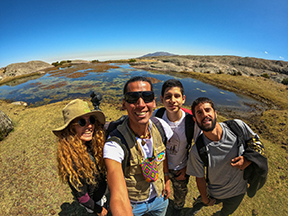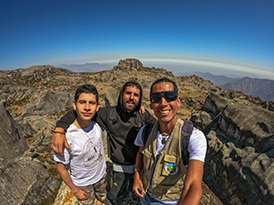The Knight Center for Environmental Journalism recently taught an online environmental journalism to a group of university students in Peru. This is one of the stories produced during that effort. The program was funded by the U.S. Embassy in Lima.
By Alvaro Benavente
Six hours from Lima, three buses and four hours of walking — depending on your physical performance – is the fifth modern wonder of Peru, Marcahuasi.
 Located near the town of San Pedro de Casta in the province of Huarochirí, Lima, it is one of the highest plateaus in the world (4,100 meters above sea level), with 4 square kilometers of rock formations, spectacular abysses, lagoons, flora, fauna and a sky in which you can see the Milky Way.
Located near the town of San Pedro de Casta in the province of Huarochirí, Lima, it is one of the highest plateaus in the world (4,100 meters above sea level), with 4 square kilometers of rock formations, spectacular abysses, lagoons, flora, fauna and a sky in which you can see the Milky Way.
Without a doubt, it’s quite a visual show known among the hikers of Peru.
Twenty minutes from the town of San Pedro de Casta is the “Casa del Protector de Marcahuasi,” an eco-village that offers accommodation services, experiential ecological camping, a vegetarian restaurant and workshops on agroecology, bioconstruction and other topics.
One of the owners of this ecovillage, Gerther Mongrut, tells us that it practices sustainable methods to reduce its carbon and water footprint, such as eco bricks, a dry toilet and vermiculture.
“We try to ensure that the water has a fairly broad function in its course and that it is not used for only one thing,” he says.
We value its existence, and that is why we created some techniques to save water, such as the shower, which goes to the orchards through canals,” Mongrut tells us.
Is it possible that this lifestyle can be applied in urban areas like Lima?
Gerther mentions that it depends on public policies and neighborhood organizations.
 On the other hand, even in San Pedro de Casta, a town close to “La casa del protector de Marcahuasi,” there is much to be done for there to be good environmental management.
On the other hand, even in San Pedro de Casta, a town close to “La casa del protector de Marcahuasi,” there is much to be done for there to be good environmental management.
That is because national tourism does not take the necessary measures to stop the degradation of this natural paradise.
As they told us in the ecovillage, “The communal tourism directive does not have the capacity to counteract these actions, much less the municipality.”
 Apart from San Pedro de Casta, there are also other nearby communities that are aware that there is a global environmental crisis.
Apart from San Pedro de Casta, there are also other nearby communities that are aware that there is a global environmental crisis.
However, according to the owners of La casa del protector, they do not take much interest, especially the consequences of solid waste such as plastic and metal.
For this reason, institutions such as the University of César Vallejo recommend holding informational talks to residents of Huarochirí and tourists who enter tourist areas.
